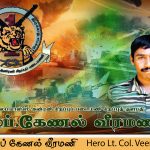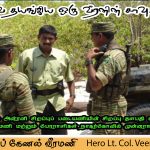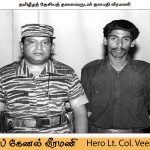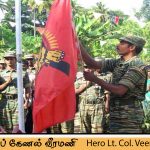

Even Death is Afraid of the Maveeran Hero Lt. Col. Veeramani
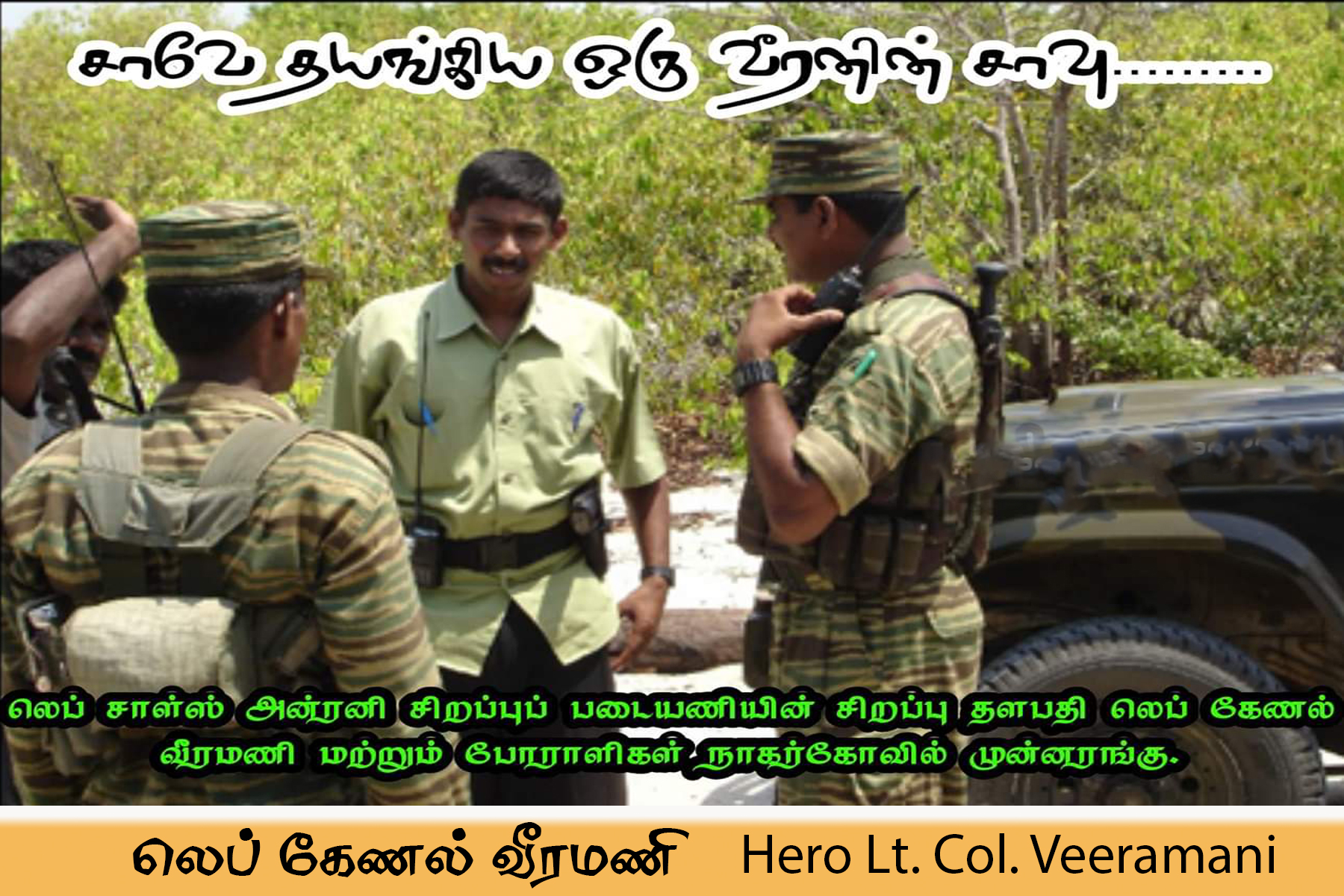
Lt. Colonel Veeramani Subramaniam Vadivelu (12.07.1975 – 24.05.2006) was a Maveeran hero that was killed by a bomb that accidently exploded in Kudarrapu.
On the Sinhala battlefields, a very tall and slender man with a twinkle in his eyes wanders the battlefield at midnight. On his neck, hangs a necklace made from a single tooth. He can be seen at one moment and gone in the next. No one has been able to shoot at him since no one would know where he is or whether it him. Even if a hundred people searched for him, no one has ever been able to find and capture him. If there is ever a story of such devil roaming the Sinhala battlegrounds, that person is Veeramani.
The heroic story of Veeramani has been told as a tradition since his death. His actions and deeds are not exaggerated and are entirely non-fiction. Veeramani is a regarded as a hero. The stories about him will leave many in disbelief and some may dismiss the claims as ridiculous, but everyone who knew him personally knows this as truth. To add interest, many will describe him in mythical ways. For new members, his stories are told with the intention to teach.
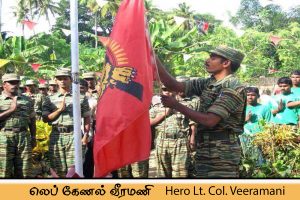
Now that he has passed, it is time to tell his story to everyone. Veeramini unfortunately did not die in combat but was killed on the shoreside. Even death was afraid to meet him on the battlefield, for he would not bend down if the face of death knealed for him. Pillaiyar breaks his horn and wrote story of epic (Bharatham)as he draws spy information in his notebook on whether he broke the spine of death. Saying what?
Senior Commander Brigadier Balraj shared with us his story. He said it was Veeramani who illuminated the LTTE during the dark periods of the Kilinochchi occupation. During operation Satjaya after the LTTE retreat, it was difficult to locate the Sri Lankan army’s camp and their front-line barricade on the battlefields of Kilinochi. The Sri Lankan army had secured their camp with a series of patrols and observation posts, which was innovative from their conventional enemy military operations. Thus, in the beginning it was a difficult task to escape as enemy troops operating outside this zone kept attacking from all sides. No one knew what was going on, therefore it was a difficult task to find the front-line guard to attack and advance.
SLA troops operating outside this zone were always attacking them. No one knew how their base was structured, how many troops there were present, what their strengths were or where their artillery was. There were also high barriers that would keep LTTE spies from entering. Several attempts at reconnaissance failed, thus Veeramani was needed there. It was decided to call Veeramani and send him outside using an innovative technique. Veeramani agreed to the challenging strategy and got ready with his team to go inside.
Veeramani’s team successfully infiltrated their base on the second day. Unfortunately, they were surrounded and subdued. The team disintegrated. Commander Brigadier Balraj, who sent out to the team, received the message that this happened. No news came from the inside and no news was received the next day. On the fourth day two spies arrived.
They noted that the team disintegrated and explained what had happened. They stated that the team had barely escaped. Veeramani was speculated to be dead. No word of him came on the fifth or sixth day. Therefore, the Commander sent information to the General Secretariat that Veeramani was a Veerachavu. How could Veeramani, who was presumed dead, be alive? Nine days past, but on the tenth day it was reported that some civilians in Chundikkulam had captured two soldiers who had come out of the guard that had fainted. When we rushed there, it was revealed that one of these soldiers were our hero and fellow spy Veeramani. He entered Kilinochchi and spent eleven days in Chundikulam.
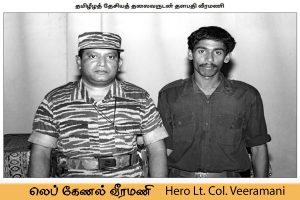
He came with valuable information, unbearable life experiences, and invaluable lessons. He provided a site layout of Kilinochchi, and thus Kilinochchi became a beacon for the LTTE. His mother shouldn’t have to hear that their son who was presumed dead would later be found alive. After the collapse of his team, LTTE troops looked around the site for two more days and found bodies that were still alive. According to Veeramani, “We were not able to leave when we tried. Every day we wandered around looking for a new way to escape. We searched, chasing hunger, thirst, and dizziness with an emaciated body.” He described information about eating green palm fruit and drinking their’s urine.
These were the dark times for the Tigers, but Veeramani was the mastermind behind the conquest of Kilinochchi and the capture. Veeramani was instrumental in capturing the eastern part of the city by attacking Kilinochchi on the day the proud-hearted Sinhalese would take a bus from Kilinochchi to the Thalathamaalikai on the 50th Independence Day of Sri Lanka. Veeramani, who played a key role in spying on the Kilinochchi base Oyatha Alai-02, lead an attack on this base which helped with the liberation of Kilinochchi. After the 1990s, there was no battlefield in Vanni that he did not see and no battlefield that he did not spy on.
One soldier of his team said, “[He] told me to stay within bushes, as he crossed the road to reach the Kilinochchi Kannan Temple with handbombs. Soliders from the army walked along the curve, and I thought it was the end of our stories here. He did not think to run, instead with his handbomb on Army’s side, he jumped and shouted ‘Atta Usappang’. The bomb struck shortly in front of a crowd of Army soldiers who stumbled over his command. He pulled me away as Amy recovered from this shock.” This event happened in 1997, when Kilinochchi was a tight spot for the A9 route capture.
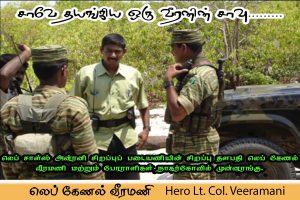 Troops searched for him in broad daylight in a compound of 2,000 people, but he was not able to be found. Somewhere in the depth bushes Veeramani will remain hidden, squeezing his body and holding onto his spirit. No one would think he was able to if they saw Veeramani. He will be hidden within enemy camps, hapilly taking notes without being seen. He would have sifted through the camps like a happy mood with qualityof fishing in a muddy pond. A little further on, on the left side of the Manjula Bakery junction, behind the market, lies the brickly chaff bushes. We figured out the place for the daytime sleeping and lay in the middle of the bushes, doing the boot cleaning.
Troops searched for him in broad daylight in a compound of 2,000 people, but he was not able to be found. Somewhere in the depth bushes Veeramani will remain hidden, squeezing his body and holding onto his spirit. No one would think he was able to if they saw Veeramani. He will be hidden within enemy camps, hapilly taking notes without being seen. He would have sifted through the camps like a happy mood with qualityof fishing in a muddy pond. A little further on, on the left side of the Manjula Bakery junction, behind the market, lies the brickly chaff bushes. We figured out the place for the daytime sleeping and lay in the middle of the bushes, doing the boot cleaning.
As the army traveled by the tractors along the road, they suddenly stopped and headed towards the prickly chaff bushes. They shook the branches. The bottom of the brickly chaff (Nayuruvi bushes) bushes was removed and bottomed out with the top was padded. Veeramani said, “To think that we would have seen. We could not sleep either with the army looking for us.” He murmured as the bomb clip exploded. The army then dragged our hammered wooden sticks and climbed into the rugged box for firewood. Laughter and hatred everywhere. “There is no tension if Veeramani goes to spy with his brother. “Even if he dies, he will die with a smile” as many have said looking at the sky. Those who stood with Veeramani tell his story. If you listen to them, you know that Veeramani’s actions on the battlefield is an incredible defeat impossible to do.
“One day before operation Edipala in Mannar, we were on our way to enter the army’s base. We passed a large cut and waterfront. It was still a short distance from the army barricade which had harsh terrain and barbed wire fences. You must cross it and infiltrate the guards to go inside. Just then a group of the enemies spotted us and started moving toward us outside the guard posts. Veeramani saw that the enemy was looking at us and was getting ready to besiege us.
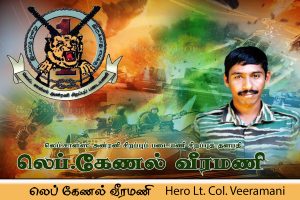
In front of us was open ground and water to the right. The enemy military team was moving in on the left getting ready to encircle us. I had thought of running back as the only way to escape, but Veeramani directed us to run towards the barrier where the Army guard stood. We went and stood between the barbed wire and landmines. The enemy team appeared and started searching for us but was amazed at how quickly we disappeared. It was a very interesting strategy that Veeramani used. We passed the guards and entered before the enemy team encircled us and returned to their site. “The enemy couldn’t even imagine this action”, Senior Commander Brigadier Balraj writes in his memoir. In another instance when Veeramani tried to cross the sand barriers past enemy guards to spy on the Elephant camp, the army had spotted them. The army began to fire at them but since Veeramani spoke in the Sinhala language, he was able to state something that made them stop shooting.
Veeramani was the one who stood within the enemy caves and ordered not to shoot at the enemy. He continued to spy within this enemy’s territory. Special Commander Charles Antony Gopith once said, “We spied under the leadership of Veeramani. He once told us to cross in water through a lake as we were coming back from a cave. Was that even possible? Would the army be able to find us easily? The main difficulty was that the Army had an observation station in middle of the water.
This loft was able to spot fish within water and even rats running onto shore. We felt it was an impossible task. “How could we go this way?” Veeramani said “Come. They will do nothing.” As we walked towards the Army’s observation loft and came under their view, I was trembling. When the army’s soldiers came down from their observation loft about to see us, Veeramani stopped and climbed their ladder. He said “Gautha” and something else in a Sinhala language that he knew. As the water rose to our chests, Veermani returned and discussed what he observed. In the loft, there were two soliders sleeping.
When our team returned to our base, we asked Veeramani what our next plan was. He said, “If we are in danger, it’s wise to stand at the feet of our enemy.” Although confusing at first, this was the lesson that Veeramani taught us. The army would not shoot at us because it would put them at great risk. According to Veeramani, a warrior would want to kill his enemy without the risk of dying. The army is afraid to shoot at us because they fear that they will be shot at in return and killed as well. If we have moved far enough, the army would then try to coordinate a team and try to attack us. From Veeramani, one can learn the many innovative techniques. But he is not with us.
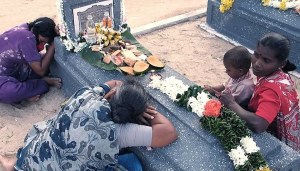 Veeramani’s main talent is that he knows Army’s strength . Since he has survived behind enemy lines, he knows very well what the Army will and will not do, their strengths and weaknesses, and their decision-making process. He also narrates the intimate “stories” of the Armies and always has a crowd around him laughing. Brigadier Theepan, a senior general who saw his intelligence and leadership in leading troops in battle with both courage and confidence, introduced him to leader as a battlefield commander.
Veeramani’s main talent is that he knows Army’s strength . Since he has survived behind enemy lines, he knows very well what the Army will and will not do, their strengths and weaknesses, and their decision-making process. He also narrates the intimate “stories” of the Armies and always has a crowd around him laughing. Brigadier Theepan, a senior general who saw his intelligence and leadership in leading troops in battle with both courage and confidence, introduced him to leader as a battlefield commander.
Oyata Alai – 03. When the battle started in Ottusuttan, Veeramani put his team on the departure platform and told the story “Boys! Remember what I said. Break the barrier and jump in to rescue of and shout “Atta Usappang“. If the army shows their hand, throw a grenade, and shoot at them. Remember, the term “surrender” should be used to describe the “Atta Usappang”. Veeramani will have the technology to provoke curiosity and courage, instead of the kind of tension and pressure that militants usually have before a fight starts like this.
When it was decided to attack the Elephant Pass at Oyatha Alai-03, the leader planned to capture Paranthan Umayalpuram and the edgeways Vettilaikkeeni in the first phase to isolate the center. But neither the wide-ranging attack nor the capture of the Vettilaikkeni Pullaaveli field were successful. It was then decided to launch an attack on Paranthan led by Commander Brigadier Theepan. Brigadier Theepan, who was consulting with the leader to start the war during the day, called Veeramani to start such a dangerous battle. It would also be very convenient in defensive combat for a legacy to lead the artillery and ranks.
The commander decided that the first daytime attack on an enemy that did not expect a battle during the day was likely to succeed. The commander decided that the first daytime attack on a clueless enemy would be worth the risk. In Oyaatha Alai 2 the enemy was defeated by making them tried to repel the defeat. Veeramani was fielded as a team commander. Commander Theepan appointed Veeramani as a divisional leader for the battle which will now begin in broad daylight. Veeramani went and won. Commander Theepan said. “At one point in the attack, Veeramani captured armies’ places that were being scorched by the armies’ tanks. Veeramani’s choice at that point is to either return the team safely or face the tanks. Veeramani kept his small team and defeated those tanks. That is what gave us success. One day the Paranthan became in our possession.

During the battle, Oyata Alai-03, the LTTE entered Thenmaraadsi. Through Thenmaraadsi, they advanced up to Ariyala. When Veeramani was stationed with his teams in Ariyalai, the appointed Commander-in-Chief Sarath Fonseka, launched a force operation called “Ginigira”. Veeramani fought against it with his team. The information was received by the Special Forces Commander Charles Antany. Charles Antany hurried their, but he was too late. Veeramani had finished the fight. Sarath Fonseka Jaffna for the failure of a spontaneous operation without the orders of HQ to send hundreds of army bodies and hundreds of wounded soldiers to Colombo. Was removed from the post of commander.
The leader praised Veeramani for his unique talents. Veeramani later became the Deputy Commander-in-Chief of Charles Antany’s Special Forces. He became the Special Commander of the Brigade as well. Veeramani was the first participant in carrying his group in the 1990 Mankulam attack. He saw his fiftieth battlefield in 2001 as a special commander for the ‘Theech Suvalai” despite being injured eight times. When he was finally in command for the field front in Nagercoil, Veeramani spoke in front of the people who were trying to see the tigers’ militants. Veeramani said within his speech, Jaffna by Sarath Fonseka. I was the first to snatch the post of Commander. He is fighting for the post of Commander-in-Chief. If he starts a fight, let him leave the army
In the evening time, People and militants gathered at the Kilinochchi Cultural Hall and lifted Veeramani’s casket. His wife was hugging and crying, mourning within the large crowd. The soldier who saw at least fifty battles, laid quietly in the casket. The sight of that made us feel greatly saddened. Senior Commander Parigadier Balraj recalled, “Veeramani was injured when he was trying to catch a fish when a bomb exploded. I was shocked. They believed that because it was just his hand that was injured, he would be okay. After several moments his condition worsened, and he passed away.”
News eventually broke that Veeramani was finally dead. Humans are afraid of death except Veeramani. Without any mercy or charity, a huge warrior was brought down at the beach. Since he was the leader of a mobile spy college, all his knowledge was lost after his death and burrial. The fact that Veeramani will not return makes us worry greatly.
We went to his home 31 days after his death, and we heard a noise from inside the house. They said that Veeramani’s picture fell, and the glass broke. “I saw him alive in the film to pay homage to the film. The glass must have been broken for his soul to come out.” I turned and looked at his face in the picture and was sunk with grief for his loss. That’s what it felt like for everyone there. For the Sinhala soldiers stationed in the Vanni, the mesmerizing gleaming eyes, shiny-face, and elongated white-toothed solider that roamed their bases at night screaming “Atta Usappang” had mysteriously exploded and disappeared. They may be comforted that they no longer need to worry about the devil that roamed the Sinhala battlefields at night.
Kaviyazhkan (Friend)
Tamil Eelam Tigers ( June – July : 2006)
Click below for more articles
Veeramani paper1
Vereamani paper
